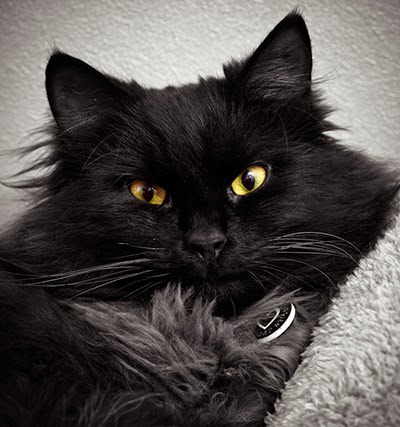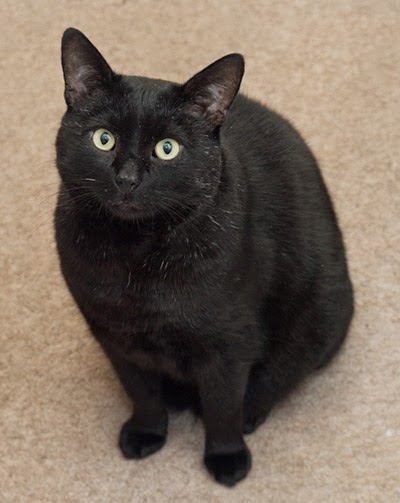Cats
A post from professional photographer Kathryn Collinson
Black and black-and-white cats are more difficult to rehome and unfortunately they are also more difficult to photograph. With National Black Cat Day celebrated this month, here are some useful tips for taking photos which capture the beauty and personality of the black cat.
1. Prepare yourself and the cat: Fluff shows up more on black fur and will be obvious in photos, so for cats that like a fuss, the first thing to do is defluff. If it’s not chilly, use a damp cloth (not wet otherwise the fur will look wet) and give the cat a relaxing stroke over to help them look their best.
As cats may not want to sit still for long, especially if you are trying to take a photo, get everything ready in advance. Also try taking a photo just after they have eaten or naturally woken up. They are more likely to be a bit sleepy and more relaxed.
Enlist some help to attract the cat's attention. Get someone to squeak a toy just behind you, or dangle a toy out of view of the camera. Don’t forget to give the cat a toy to actually pounce on once you’ve got your pictures!
2. Get the background right: Avoid white backgrounds; a black cat on a white background might look good to the naked eye, but in photography it creates too much contrast. This creates problems for your camera as it will struggle to focus and to expose accurately. Go for a background which complements the colouring of a cat's eyes such as gold or green, or for something which sets off their fur colour. A lot of black cats are really dark brown, so browns, reds or blues work well.
Try to avoid including too much background in the shot. Not only will it be a weaker composition, but also the camera will expose for the background not the cat and you could end up with just a featureless black blob. If the cat enjoys contact, get in close as this forces the camera to expose for the cat.
If you are using a smartphone, don't be tempted to use the zoom feature. The camera basically guesses what the image should look like which is why zoomed images always look degraded. It is much better to crop in afterwards.
3. Switch on the lights: You need lots of light to photograph a black cat, as light is absorbed and reflected by their fur. Avoid the flash, especially on smartphones, and use natural light or a lamp. To give the fur texture, try and angle the light across the cat, but don’t dazzle the cat.
4. Play with exposure: Most cameras have an exposure compensation (EV) button (+/-) which allows you to override your camera's exposure settings. If your photos aren't coming out as you hoped, try these solutions:
If you don't want to manually set the exposure check to see if your camera has AEB (multi-exposure bracketing). By just pressing the shutter once, you can take three shots of the same scene at different exposures (normal exposure; under-exposure; over-exposure). This saves you manually adjusting the exposure between each individual shot. This can be particularly useful for black-and-white cats as by default they are high-contrast. Fingers crossed the cat stays still long enough!
5. Consider other apps: If you are using a smartphone consider the other camera apps available. They tend to be better than the stock camera app and will give you more controlled shooting. The following apps are worth considering:
Once you've installed an app, practice and get to grips fully with the features before you need to use it.
And finally, if you are still struggling to get a decent photo, get the cat to take a selfie with Snapcat! They chase an icon around the screen and every time they tap it with their paw it takes a photo. But again, only use if for a short time and remember to give the cat a real toy to play with and catch afterwards, to avoid frustration.
This post has been written by a guest blogger. The views expressed in this post do not necessarily reflect the views of Cats Protection.
- Bigging Up Black Cats
Cats Protection’s annual celebration of black and black-and-white cats is back on Tuesday 27 October 2015 to encourage the adoption of monochrome moggies. Black cats in CP care are often overlooked by potential adopters and take on average a week longer...
- On The Prowl For A Black Cat Champion
Is your monochrome moggy utterly brilliant? Cats Protection's National Black Cat Day 2015 is on 27 October and we’re once again on the prowl for this year’s Black Cat Champion in our brand new competition. To enter, visit our national Facebook...
- A Collection Of Black Cat Tales
In honour of National Black Cat Day, we’ve collected photographs, stories, tweets and more from around the internet in celebration of black and black-and-white cats and kittens. Why do we celebrate monochrome moggies every year? Sadly, black and black-and-white...
- The Most Popular Black Cat Names
It seems that many owners of monochrome felines favour traditional names for their pets. We conducted a survey of over 18,000 cat owners on Facebook (see the results in our infographic) which revealed the most common cat names from across the UK. Based...
- Behind The Scenes - Our Support Adoption For Pets Video Shoot
A post from our volunteer guest blogger, Russell Stedman As I cruised along the country roads of Surrey towards Cat Protection’s Haselmere Adoption Centre on Wednesday 11 June, the warm sun was streaming through the trees and I knew we were going...
Cats
Secrets to taking successful photos of black cats
A post from professional photographer Kathryn Collinson
Black and black-and-white cats are more difficult to rehome and unfortunately they are also more difficult to photograph. With National Black Cat Day celebrated this month, here are some useful tips for taking photos which capture the beauty and personality of the black cat.
 |
| Photo courtesy of Kathryn Collinson |
As cats may not want to sit still for long, especially if you are trying to take a photo, get everything ready in advance. Also try taking a photo just after they have eaten or naturally woken up. They are more likely to be a bit sleepy and more relaxed.
Enlist some help to attract the cat's attention. Get someone to squeak a toy just behind you, or dangle a toy out of view of the camera. Don’t forget to give the cat a toy to actually pounce on once you’ve got your pictures!
2. Get the background right: Avoid white backgrounds; a black cat on a white background might look good to the naked eye, but in photography it creates too much contrast. This creates problems for your camera as it will struggle to focus and to expose accurately. Go for a background which complements the colouring of a cat's eyes such as gold or green, or for something which sets off their fur colour. A lot of black cats are really dark brown, so browns, reds or blues work well.
Try to avoid including too much background in the shot. Not only will it be a weaker composition, but also the camera will expose for the background not the cat and you could end up with just a featureless black blob. If the cat enjoys contact, get in close as this forces the camera to expose for the cat.
If you are using a smartphone, don't be tempted to use the zoom feature. The camera basically guesses what the image should look like which is why zoomed images always look degraded. It is much better to crop in afterwards.
 |
| Photo courtesy of Kathryn Collinson |
4. Play with exposure: Most cameras have an exposure compensation (EV) button (+/-) which allows you to override your camera's exposure settings. If your photos aren't coming out as you hoped, try these solutions:
- If the cat looks grey rather than black (over-exposed), you need to let less light into the camera by decreasing the exposure. Set the EV button to - 0.7 or -1.0 and try again
- If the cat is just a black mass with no discernible features (under-exposed), you need to let more light into the camera by increasing the exposure. Set the EV to +0.7 or +1.0
If you don't want to manually set the exposure check to see if your camera has AEB (multi-exposure bracketing). By just pressing the shutter once, you can take three shots of the same scene at different exposures (normal exposure; under-exposure; over-exposure). This saves you manually adjusting the exposure between each individual shot. This can be particularly useful for black-and-white cats as by default they are high-contrast. Fingers crossed the cat stays still long enough!
 |
| Photo courtesy of Kathryn Collinson |
- Camera Awesome
- Camera FV-5
- Google Camera
Once you've installed an app, practice and get to grips fully with the features before you need to use it.
And finally, if you are still struggling to get a decent photo, get the cat to take a selfie with Snapcat! They chase an icon around the screen and every time they tap it with their paw it takes a photo. But again, only use if for a short time and remember to give the cat a real toy to play with and catch afterwards, to avoid frustration.
This post has been written by a guest blogger. The views expressed in this post do not necessarily reflect the views of Cats Protection.
- Bigging Up Black Cats
Cats Protection’s annual celebration of black and black-and-white cats is back on Tuesday 27 October 2015 to encourage the adoption of monochrome moggies. Black cats in CP care are often overlooked by potential adopters and take on average a week longer...
- On The Prowl For A Black Cat Champion
Is your monochrome moggy utterly brilliant? Cats Protection's National Black Cat Day 2015 is on 27 October and we’re once again on the prowl for this year’s Black Cat Champion in our brand new competition. To enter, visit our national Facebook...
- A Collection Of Black Cat Tales
In honour of National Black Cat Day, we’ve collected photographs, stories, tweets and more from around the internet in celebration of black and black-and-white cats and kittens. Why do we celebrate monochrome moggies every year? Sadly, black and black-and-white...
- The Most Popular Black Cat Names
It seems that many owners of monochrome felines favour traditional names for their pets. We conducted a survey of over 18,000 cat owners on Facebook (see the results in our infographic) which revealed the most common cat names from across the UK. Based...
- Behind The Scenes - Our Support Adoption For Pets Video Shoot
A post from our volunteer guest blogger, Russell Stedman As I cruised along the country roads of Surrey towards Cat Protection’s Haselmere Adoption Centre on Wednesday 11 June, the warm sun was streaming through the trees and I knew we were going...
